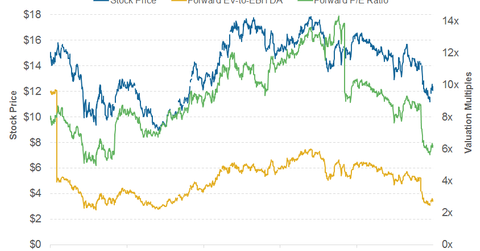An Investor’s Guide to Ford’s Valuation
Ford’s valuation multiples are in a negative trend. This could be because of the concern that US auto sales may have already peaked last year.
March 15 2016, Updated 9:05 p.m. ET

Ford’ valuation methods
There are a variety of valuation methods available to value Ford Motor Company (F). We believe investors should use a combination of discounted cash flow and valuation multiples to value the company.
First, let’s use a relative valuation method based on Ford’s valuation multiples. We’ll discuss the DCF (discount cash flow) valuation method later.
Forward EV-to-EBITDA
The EV-to-EBITDA (enterprise value to earnings before interest, tax, depreciation, and amortization) multiple is an important relative valuation multiple. It’s generally used for capital-intensive industries such as the automotive industry (XLY).
Ford has a forward EV-to-EBITDA multiple of 2.8x for the next 12 months. This is higher than its closest peer, General Motors (GM), which has an EV-to-EBITDA multiple of 2.1x for the same period.
As you can see in the chart above, Ford’s valuation multiples are in a negative trend. This could be because of the concern that US auto sales may have already peaked last year.
Forward price-to-earnings multiple
The forward PE (price-to-earnings) multiple takes into account the equity portion of a company. As of January 7, 2016, Ford’s forward PE ratio, based on forecast earnings for the next 12 months, stands at 6.2x, higher than General Motors’ 5.3x.
Toyota’s (TM) forward PE multiple is trading at 7.6x, higher than all mainstream US automakers. GM’s and Ford’s high dependency on the US auto market could be one of the reasons why Wall Street is valuing these automakers lower than Toyota.
Discounted cash-flow method
Note that Ford Motor Company has a mature business model with predictable cash flows, unlike any new auto company (FXD) such as Tesla (TSLA). This makes the DCF method appropriate for valuing Ford. However, the cyclical nature of the automotive industry could be a challenge when using the DCF method to value the company.
It’s also important for investors to understand that valuation multiples can change based on many internal and external risk factors. We’ll discuss these factors in the next and final article of this series.
